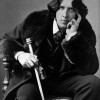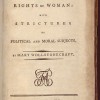
Lana L. Dalley, “On Martineau’s Illustrations of Political Economy, 1832-34″
Harriet Martineau’s conception of fictional and economic discourses as compatible, her confidence that a woman could effectively and authoritatively write about political economy, and Illustrations’ resonance throughout the period mark Illustrations of Political Economy‘s conception, publication, and reception as important events in the history of nineteenth-century literature and culture.

Jill Rappoport, “Wives and Sons: Coverture, Primogeniture, and Married Women’s Property”
Prior to political agitation for the reform of married women’s property laws, nineteenth-century fiction emphasized primogeniture (the common law doctrine of consolidating wealth in the hands of eldest sons) alongside coverture (the common law doctrine that marriage voided a wife’s separate legal identity) in order to show how both contributed to women’s economic marginalization. The reform movement, however, focused its attention on coverture, and by the time of the 1870 Act, fiction begins to divorce its sympathy for women’s subjugation in coverture from its treatment of women’s condition with respect to primogeniture. This case study of novels by Jane Austen and George Eliot suggests that, as coverture comes under closer scrutiny, primogeniture is no longer showcased as one of women’s most significant economic disadvantages. Instead, the claims of primogeniture begin to appear as an argument against women’s rights to property.

Erik Simpson, “On Corinne, Or Italy”
Germaine de Staël’s Corinne, Or Italy was published in French in 1807 and was quickly translated into English. It became a touchstone for nineteenth-century conceptions of women’s creativity and the life of the woman writer, as well as an important formulation of analogies between models of artistic creation and political systems. The novel’s portrayal of Italian improvisers also helped produce the modern usage of “improvisation” and related terms in English.

Andrew Elfenbein, “On the Trials of Oscar Wilde: Myths and Realities”
This essay contradicts myths often found in popular writing about Oscar Wilde: (1) Wilde was an aristocrat; (2) Victorians knew nothing about homosexuality; (3) Wilde was put on trial for being a homosexual; (4) once Wilde was on trial, his conviction was inevitable; and (5) after the trials, Wilde disappeared. It concludes by speculating on future directions for work on Wilde and sexuality.

Ghislaine McDayter, “On the Publication of William Godwin’s Memoirs of the Author of A Vindication of the Rights of Woman, 1798″
William Godwin’s publication of Mary Wollstonecraft’s memoirs in 1798 had a massive impact on Wollstonecraft’s posthumous reputation and literary legacy. While Godwin’s refusal to finesse an increasingly conservative readership by downplaying his wife’s sexual independence in the Memoirs may have initiated a violent rejection of Wollstonecraft’s work for nearly a century, it also highlighted the important political radicalism of her work that might otherwise have been forgotten.

Rachel Ablow, “‘One Flesh,’ One Person, and the 1870 Married Women’s Property Act”
The 1870 Married Women’s Property Act marked a shift in the way marriage was regarded in England. Before that point, debates relating to divorce, married women’s property, and child custody revolved around different ideas of what constituted the good marriage: while many conservatives claimed that coverture (the legal doctrine that absorbed a married woman’s legal identity into her husband’s) guaranteed sympathetic communion between spouses, many progressives claimed that only legal equality could enable husbands and wives to enter fully into one another’s feelings. The 1870 Act marked a shift away from conservatives’ claims and towards those of progressives.

Brenda Assael, “On Dinners and Diners and Restaurant Culture in Late Nineteenth-Century London”
Lieutenant Colonel Nathaniel Newnham-Davis’s Dinners and Diners, published in 1899, provides a lively and valuable introduction to the restaurant in late nineteenth-century London, an aspect of Victorian metropolitan experience that has been largely overlooked by historians. This article uses Dinners and Diners to explore three aspects of Victorian metropolitan culture that are dramatized through public eating: first, the centrality of cosmopolitanism; second, the relationship between changing gender roles and new forms of urban sociability; and third, the significance of the theater and theatricality in late-Victorian culture.

Anne D. Wallace, “On the Deceased Wife’s Sister Controversy, 1835-1907”
For more than 70 years the English engaged in heated public debate about whether a man should be able to marry his deceased wife’s sister. While twentieth-century scholars either ignored this controversy or attributed it to Victorian obsessions with psychological and/or cultural repressions of incest, the documents of the debate suggest that anxiety about the anomalous legal and economic autonomy of unmarried adult sisters drove the controversy. Recent interest in the Marriage with a Deceased Wife’s Sister (MDWS) debates seems fueled by increasing scholarly perceptions of “family” and its various relational terms, including “sister,” as historically and culturally embedded constructs that vary both within and across historical/cultural sites. Re-examined through this lens, the MDWS debates can be understood as negotiating competing ideals of “family” and “household” in which the adult unmarried sister either provided valuable material and/or affective support of the marriage or represented a disturbing intrusion of labor into the domestic space. For literary scholars, the MDWS debates signal the necessity of reading representations of family and, specifically, sibling relations without assuming the stability and/or uniformity of ideas and practices of “family” during the period.

Anne Mellor, “On the Publication of Mary Wollstonecraft’s A Vindication of the Rights of Woman“
Mary Wollstonecraft’s Vindication of the Rights of Woman (1792) laid out the tenets of what today we call ‘equality’ or ‘liberal’ feminist theory. She further promoted a new model of the nation grounded on a family politics produced by egalitarian marriages.
